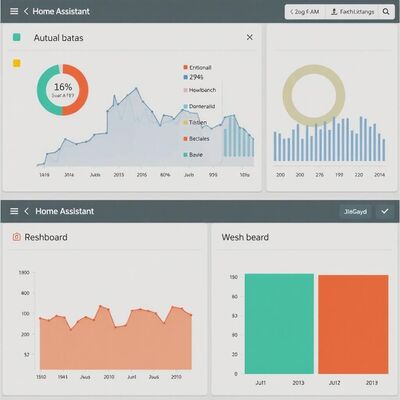- 1-905-452-8193
- Contact Us
- Member Login
- Get Listed Today
- 220,911 members

The global count of smart homes is forecasted to surpass 400 million by 2024, while the US is expected to have around 77.10 million smart homes by 2025.
By seamlessly integrating live data into user-friendly interfaces, these dashboards offer unparalleled control, convenience, and insights for homeowners. Let's explore how real-time data can revolutionize your smart home experience and examine examples of dashboards that harness the power of live data.
Real-time data enables instant feedback and control, empowering homeowners to interact with their devices more effectively. For instance, monitoring the exact status of smart locks, lighting systems, or climate control devices allows for precise adjustments. If you notice your living room temperature rising beyond the set threshold, a real-time home assistant dashboard lets you immediately tweak the thermostat, ensuring comfort without delay.
Live energy consumption metrics help users identify and eliminate waste. Imagine a dashboard showing real-time electricity usage for every room or device. With this data, you can identify energy-hungry appliances and schedule their operation during off-peak hours, reducing utility bills and environmental impact.
Real-time data can detect anomalies or malfunctions in your smart devices. For instance, if a water leak sensor in the basement detects unusual activity, your smart home dashboard can send instant alerts, helping you take action before significant damage occurs. Similarly, tracking the health of connected devices ensures timely maintenance, extending their lifespan.
Home Assistant Dashboards that leverage real-time data enable smarter automation. For example, if your home assistant dashboard integrates weather data, it can adjust indoor lighting or blinds automatically based on external conditions. Real-time occupancy sensors can adapt settings like room temperature and lighting to your presence, delivering a tailored living experience.
One of the most visually engaging options, Home assistant 3D floor plan displays live data across different rooms in a virtual layout of your home. These dashboards allow you to monitor and control devices such as lights, cameras, and climate systems with a simple tap on the corresponding room. For instance, turning off lights in unoccupied rooms becomes a breeze when you see their real-time status in the 3D interface.
These dashboards focus on live energy consumption metrics, providing detailed insights into how your smart home uses power. Some advanced dashboards even include predictive analytics, showing potential savings if certain devices are turned off or operated during low-demand periods.
Real-time surveillance dashboards integrate live feeds from smart cameras, doorbells, and motion sensors. Users can monitor their property in real-time, receive alerts for unusual activity, and even communicate with visitors or delivery personnel directly through the interface.
These dashboards display live temperature, humidity, and air quality metrics, allowing users to adjust HVAC systems accordingly. Integration with weather APIs can further optimize indoor environments by preparing your home for changing external conditions.
Home Assistant Dashboards integrated with AI voice assistants like Alexa, Google Assistant, or Siri provide live updates and allow hands-free control. For instance, you can ask your assistant to "show energy usage for the living room," and the dashboard will display the relevant data instantly.
These advanced dashboards provide a unified interface for controlling a wide range of devices, from lights and locks to entertainment systems. Real-time updates on the status of each device enhance coordination and streamline management.
Better Decision-Making: Access to live data empowers informed decisions about energy use, security, and device settings.
Increased Convenience: Centralized control through a dashboard eliminates the need to interact with multiple apps or interfaces.
Improved Safety: Real-time alerts for unusual activity, such as leaks or unauthorized access, enhance home security.
Customization: Home Assistant Dashboards adapt to your preferences, offering a tailored experience for each family member.
Real-time data dashboards are more than just a convenience; they represent a significant leap in home automation technology. By integrating live data into intuitive interfaces, these dashboards enhance comfort, efficiency, and security in your smart home. Whether you're a tech enthusiast or a homeowner looking for practical solutions, adopting real-time data dashboards is a step towards a smarter, more connected future. Explore the possibilities and transform your living space with the power of live data.
